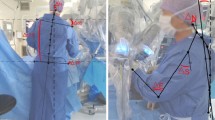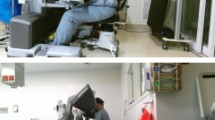Abstract
Background
Cholecystectomy was one of the first surgical procedures to be performed with laparoscopy in the 1980s. Currently, two operation setups generally are used to perform a laparoscopic cholecystectomy: the French and the American position. In the French position, the patient lies in the lithotomy position, whereas in the American position, the patient lies supine with the left arm in abduction. To find an ergonomic difference between the two operation setups the movements of the surgeon’s vertebral column were analyzed in a crossover study.
Methods
The posture of the surgeon’s vertebral column was recorded intraoperatively using an electromagnetic motion-tracking system with three sensors attached to the head and to the trunk at the levels of Th1 and S1. A three-dimensional posture analysis of the cervical and thoracolumbar spine was performed to evaluate four surgeons removing a gallbladder in the French and American position. The body angles assessed were flexion/extension of the cervical and thoracolumbar spine, axial rotation of the cervical and thoracolumbar spine, lateroflexion of the cervical and thoracolumbar spine, and the orientation of the head in the sagittal plane. For each body angle, the mean, the percentage of operation time within an ergonomic acceptable range, and the relative frequencies were calculated and compared.
Results
No statistical difference was observed in the mean body angles or in the percentages of operation time within an acceptable range between the French and the American position. The relative frequencies of the body angles might indicate a trend toward slight thoracolumbar flexion in the French position.
Conclusion
In a modern dedicated minimally invasive surgery suite, the body posture of the neck and trunk and the orientation of the head did not differ significantly between the French and American position.






Similar content being viewed by others
References
Berggren U, Gordh T, Grama D, Haglund U, Rastad J, Arvidsson D (1994) Laparoscopic versus open cholecystectomy: hospitalization, sick leave, analgesia, and trauma responses. Br J Surg 81:1362–1365
Hendolin HI, Paakonen ME, Alhava EM, Tarvainen R, Kemppinen T, Lahtinen P (2000) Laparoscopic or open cholecystectomy: a prospective randomized trial to compare postoperative pain, pulmonary function, and stress response. Eur J Surg 166:394–399
Richards C, Edwards J, Culver D, Emori TG, Tolson J, Gaynes R (2003) Does using a laparoscopic approach to cholecystectomy decrease the risk of surgical site infection? Ann Surg 237:358–362
Schellekens PC, Bijnen AB, Honing M, Lourens J, de Ruiter P (1995) Results of the introduction of laparoscopic cholecystectomy on morbidity and mortality of gallbladder surgery in a large regional hospital. Ned Tijdschr Geneeskd 139:723–727
Park A, Lee G, Seagull J, Meenagham N, Dexter D (2010) Patients benefit while surgeons suffer: an impending epidemic. J Am Coll Surg 210:306–313
Erfanian K, Luks FI, Kurkchubasche AG, Wesselhoeft CW Jr, Tracy TF Jr (2003) In-line image projection accelerates task performance in laparoscopic appendectomy. J Pediatr Surg 38:1059–1062
Hemal AK, Srinivas M, Charles AR (2001) Ergonomic problems associated with laparoscopy. J Endourol 15:499–503
Vereczkei A, Feussner H, Negele T, Fritzsche F, Seitz T, Bubb H, Horvath OP (2004) Ergonomic assessment of the static stress confronted by surgeons during laparoscopic cholecystectomy. Surg Endosc 18:1118–1122
Van Det MJ, Meijerink WJHJ, Hoff C, Van Veelen MA, Pierie JPEN (2009) Optimal ergonomics for laparoscopic surgery in minimally invasive surgery suites: a review and guidelines. Surg Endosc 23:1279–1285
Van Veelen MA, Jakimowicz JJ, Kazemier G (2004) Improved physical ergonomics of laparoscopic surgery. Min Invas Ther Allied Technol 13:161–166
Mishra RK (2013) Textbook of practical laparoscopic surgery, 3rd edn. Jaypee Brothers Medical Publishers, New Delhi
Youssef Y, Lee G, Godinez C, Sutton E, Klein RV, George IM, Seagull FJ, Park A (2011) Laparoscopic cholecystectomy poses physical injury risk to surgeons: analysis of hand technique and standing position. Surg Endosc 25:2168–2174
Disclosures
Kelvin H. Kramp, Marc J. van Det, Eric R. Totte, Christiaan Hoff, and Jean-Pierre E. N. Pierie have no conflicts of interest or financial ties to disclose.
Author information
Authors and Affiliations
Corresponding author
Rights and permissions
About this article
Cite this article
Kramp, K.H., van Det, M.J., Totte, E.R. et al. Ergonomic assessment of the French and American position for laparoscopic cholecystectomy in the MIS Suite. Surg Endosc 28, 1571–1578 (2014). https://doi.org/10.1007/s00464-013-3353-1
Received:
Accepted:
Published:
Issue Date:
DOI: https://doi.org/10.1007/s00464-013-3353-1




